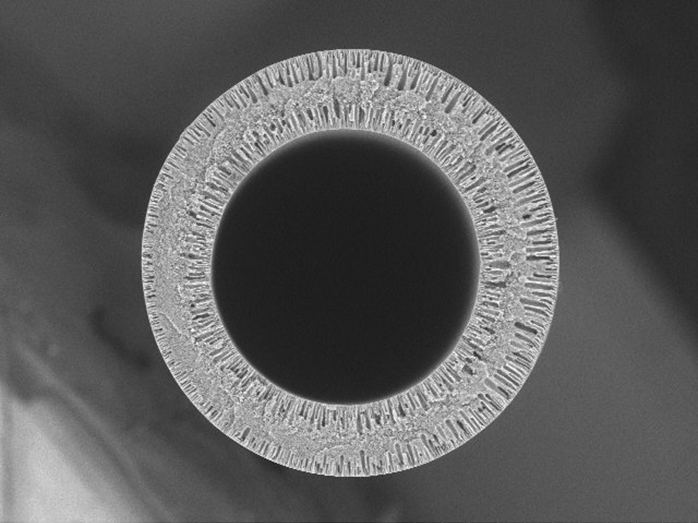
Membrane Technology: A Sustainable Environmental and Industrial Solution
Membrane-based separation is a sustainable and dignified technology that offers immense benefits to the mankind. >>>
Carbon Nanotubes
Since discovered by Iijima in 1991, carbon nanotube (CNT) has becomes an attractive nanomaterial for researchers from various applications such as nano-electronic device and sensor, energy storage, catalysis and composite material due to its superior mechanical, electrical and chemical properties. CNTs consists of rolled-up sheet of graphite which can be categorized as single-walled (one layer graphite sheet) or multi-walled (multiple layer of graphite sheets) CNTs. Since the graphite surface is inherently smooth, the cavities or bores of the CNTs could serves as rapid diffusion channels for mass transport. Furthermore, the size and properties of the CNTs can be tailored to meet specific requirements. In AMTEC, CNTs have been primarily employed as additives to enhance the separation performance as well as physical and chemical properties of our membranes for liquid (both gas and water) separation. Our researchers specialize on the functionalization and incorporation techniques of the CNTs into the polymers to produce composite membranes in the format of flat sheet and hollow fiber. AMTEC also provides the facilities to produce CNTs via chemical vapor deposition (CVD) method.
Currently, the research and development of carbon nanotubes incorporated membranes have been actively carried out. Following are some of the publications related to the CNT research conducted in AMTEC:-
- P.S. Goh, B.C. Ng, A.F. Ismail, M. Aziz, S.M. Sanip, Surfactant dispersed multi-walled carbon nanotube/polyetherimide nanocomposite membrane, Solid State Sciences, Volume 12, Issue 12, December 2010, Pages 2155-2162, ISSN 1293-2558, http://dx.doi.org/10.1016/j.solidstatesciences.2010.09.017.
- P.S. Goh , B. C. Ng , A. F. Ismail , S. M. Sanip , M. Aziz , M. A. Kassim, Effect of Dispersed Multi-Walled Carbon Nanotubes on Mixed Matrix Membrane for O2/N2 Separation, Separation Science and Technology, Volume 46, Issue. 8, 1 May 2011, Pages 1250-1261, DOI: 10.1080/01496395.2011.554952
- P.S. Goh, A.F. Ismail, S.M. Sanip, B.C. Ng, M. Aziz, Recent advances of inorganic fillers in mixed matrix membrane for gas separation, Separation and Purification Technology, Volume 81, Issue 3, 10 October 2011, Pages 243-264, ISSN 1383-5866, http://dx.doi.org/10.1016/j.seppur.2011.07.042.
- P.S. Goh, B.C. Ng, A.F. Ismail, M. Aziz, Y. Hayashi, Pre-treatment of multi-walled carbon nanotubes for polyetherimide mixed matrix hollow fiber membranes, Journal of Colloid and Interface Science, Volume 386, Issue 1, 15 November 2012, Pages 80-87, ISSN 0021-9797, http://dx.doi.org/10.1016/j.jcis.2012.07.033.
- P.S. Goh, A.F. Ismail, B.C. Ng, Carbon nanotubes for desalination: Performance evaluation and current hurdles, Desalination, Volume 308, 2 January 2013, Pages 2-14, ISSN 0011-9164, http://dx.doi.org/10.1016/j.desal.2012.07.040.
- P.S. Goh, A.F. Ismail, B.C. Ng, Carbon nanotubes for desalination – an innovative material with enormous potential, Membrane Technology, Volume 2013, Issue 9, September 2013, Pages 7-10, ISSN 0958-2118, http://dx.doi.org/10.1016/S0958-2118(13)70187-3.
- P.S. Goh, A.F. Ismail, B.C. Ng, Directional alignment of carbon nanotubes in polymer matrices: Contemporary approaches and future advances, Composites Part A: Applied Science and Manufacturing, Volume 56, January 2014, Pages 103-126, ISSN 1359-835X, http://dx.doi.org/10.1016/j.compositesa.2013.10.001.
- P.S. Goh, A.F. Ismail, N. Hilal, Nano-enabled membranes technology: Sustainable and revolutionary solutions for membrane desalination?, Desalination, Available online 23 June 2015, ISSN 0011-9164, http://dx.doi.org/10.1016/j.desal.2015.06.002.

